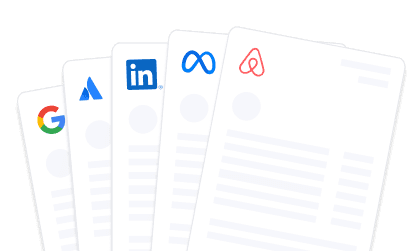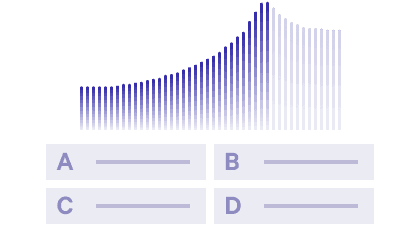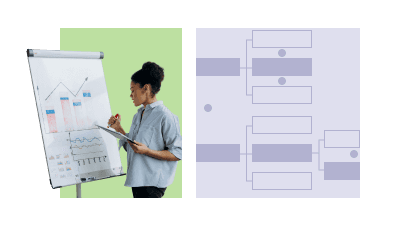The Ultimate Product Manager Interview Guide (2025)
Ace your product manager interview with our ultimate guide! Discover expert tips, top questions, and strategies to stand out and land your dream PM role.
Posted October 25, 2025

Join a free event
Learn from top coaches and industry experts in live, interactive sessions you can join for free.
Table of Contents
A product manager's job is to shape the direction of products from concept to launch. This requires a strong mix of skills from understanding user needs to leading teams. If you're preparing for a product manager interview, you need to demonstrate your expertise in these areas and more. Here’s your comprehensive guide to navigating the product manager interview process in 2025.
Read: What is Product Management?
Preparing for the Interview: Key Concepts You Should Know
Understanding the Product Manager Role
As a Product Manager (PM), your primary responsibility is to create a product that solves real user problems while aligning with business objectives. This means you must have a deep understanding of user needs and translate this knowledge into a clear product strategy. A strong product strategy acts as the roadmap for the product’s development.
User research is an essential part of this process to help you identify the underlying pain points that users may not explicitly express. By conducting surveys and interviews, you uncover the problems your product needs to address. This research forms the foundation for making informed decisions and ensures that the product meets real needs in a way that is meaningful to the target audience. Each decision you make influences the product’s success, and your ability to navigate these competing factors will determine how well the product meets both user expectations and the company’s objectives.
Read: The Different Types of Product Management: An Overview of Specialist PM Jobs
Breaking Down the PM Interview Process
The process typically involves several rounds to assess your skills and fit for the role. It starts with a phone call, where a recruiter or hiring manager will discuss your background and experience. Next is the technical interview, which evaluates your ability to communicate with technical teams and answer product-related questions. The product sense round tests your knowledge of product design, prioritization, and how you would improve existing products. Finally, the behavioral interview uses the STAR method to explore situations where you've faced challenges or achieved success.
Product Management Interview Prep: The Basics
To get ready for your interview, focus on these areas with some sample questions and answers to guide you.
Sample Question:
“How would you improve our product?”
Answer:
I took a look at your app and saw that while it works really well for power users, new users sometimes find the onboarding process confusing. To make it easier for them, I’d suggest simplifying the flow with tooltips and in-app tutorials. This would help them get started faster while still keeping the advanced features for experienced users.
Sample Question:
“How do you measure success for a product?”
Answer:
I like to track both the numbers and the feedback such as surveys or interviews, to see if it’s actually solving the problem we set out to address. This way, we can understand if it’s meeting our goals and user needs.
Sample Question:
“Tell me about a time you made a tough decision.”
Answer:
In my last role, I had to prioritize which features to release first for a product. I gathered input from customers and evaluated the technical feasibility of each option. This approach helped improve user retention by 15%.
Note: Preparing for a product management interview involves practicing these questions and refining your answers to showcase your problem-solving and ability to align product decisions with business goals.
Read: The 50 Most Common Product Manager Interview Questions (With Sample Answers)
Common Product Manager Interview Questions & How to Answer Them
Behavioral Type Questions
Hiring managers use these to understand how you’ve handled situations in the past.
For Example:
“Tell me about a time when you faced a significant challenge in a project.”
Sample Answer:
"During the development of a new payment feature, we discovered a critical bug in the payment integration system just days before the launch. My task was to ensure we still met the deadline without compromising quality. I quickly gathered the team and worked closely with the engineers to resolve the issue. We adjusted the timeline by a few days and successfully launched the feature. The result was a smooth rollout with a 10% increase in transaction success rates."
For Example:
"Tell me about a time when you had to deal with a difficult team member."
Sample Answer:
I was working on a project where one of the team members consistently missed deadlines and caused delays. I decided to have a one-on-one conversation with him to understand the root cause. It turned out they were overwhelmed with the workload but didn’t feel comfortable speaking up. I worked with them to redistribute some tasks and offered support where needed. As a result, they became more engaged, and we were able to meet the project deadlines without further delays.
Read: The 10 Most Common Product Management (PM) Behavioral Interview Questions
Technical Interview Questions
In the technical interview, you’ll be asked questions that test your ability to collaborate with technical teams.
Sample Question:
“Explain how you would prioritize features given limited resources.”
Answer:
“When prioritizing features with limited resources, I start by considering both user needs and business goals. I assess the impact of each feature on user satisfaction and align it with the company's objectives. I also collaborate with technical teams to understand the feasibility of each feature. For example, in my last project, I used a prioritization matrix to weigh user impact, business value, and technical constraints, which helped us focus on the most valuable features first.”
Sample Question:
“How would you handle estimation questions?”
Answer:
“When handling estimation questions, I rely on data from similar past projects and work closely with the technical team to understand the scope and complexity of the task. I also consider potential risks and dependencies that could affect the timeline. For instance, in a previous role, we used historical data on feature development times and added a buffer for unexpected issues, which gave us more accurate estimates and helped manage expectations with stakeholders.”
Note: The STAR method (Situation, Task, Action, Result) helps structure your answers clearly and concisely
Understanding the Interview Process: How to Navigate Each Stage
Screening Stage: What the Hiring Manager Looks for
During the screening stage, the hiring manager wants to get a sense of your background and assess whether you’re a good fit for the product management role. It is important to answer questions clearly and concisely. Focus on relevant experiences that demonstrate your ability to succeed in the role. Make sure to show how your values align with the company’s and emphasize your ability to work collaboratively within their product team.
The Product Design Interview
Product design interviews focus on how you approach designing products. Expect questions that assess your product sense, like:
Sample Question:
“How would you design a feature for a new app?”
Answer:
“I would start by identifying any issues or areas that needs improvement. Then, I’d simplify the experience by adding tooltips and interactive tutorials to guide new users. I’d also ensure the process is quick to keep users from dropping off early. Since our goal is to provide the best experience for our users, I will also include personalized recommendations that could enhance their journey and meet their needs.”
Expert Tip: Focus on the user experience, technical feasibility, and alignment with business goals.
User Research and Strategy Questions
Companies want to know how you gather insights and apply them to product development.
Sample Question:
“How would you gather user feedback for a new product?”
Answer:
“I’d gather user feedback using surveys or recommendations. Surveys would help capture broad insights, interviews would provide deeper qualitative feedback, and analytics would allow me to track user behavior and identify pain points.”
Behavioral and Culture Fit Questions
Hiring managers want to understand how you handle collaboration, decision-making, and challenges within teams.
Sample Question:
“Tell us about a time you had to influence an important stakeholder.”
Answer:
“In my previous project, I needed to align our stakeholders with a new product direction. They were hesitant about shifting priorities so I worked closely with them to understand their concerns and presented data on how the change would benefit both users and the business. We reached a consensus, and the product successfully aligned with the broader vision, which improved our overall user engagement.”
How to Stand Out in Your PM Interview
One of the best ways to prepare is by reviewing common interview questions, especially behavioral and technical questions. Once you’ve reviewed these questions, refine your answers by focusing on explaining your decision-making process. It is important to highlight how your actions directly influenced the success of the project. Sometimes, interviewers will also ask clarifying questions to better understand your thought process. If this happens, stay calm and ask for more details. This is your chance to ensure your response aligns with the interviewer's expectations.
Practice with Real-Life Scenarios
Use mock interviews or case studies to practice answering questions. This helps you gain confidence in responding to PM interview questions and refining your answers in real time.
Post-Interview: How to Follow Up & What Comes Next
After your interview, send a thank-you note to leave a lasting impression. This note should be brief and express your genuine appreciation for the opportunity to interview. Reassert your interest in the role and mention something specific from the interview to show that you were engaged and attentive.
For Example:
Subject: Thank You for the Opportunity
Dear [Interviewer’s Name],
Thank you for the opportunity to interview for the [Product Manager] role. I enjoyed learning more about [specific project or aspect discussed] and how I could contribute to the team. I remain very excited about the position and am confident my skills in [relevant skills] would be a great fit.
Thank you again for your time and consideration.
Best,[Your Name]
Once the interview is complete, it is helpful to know what to expect next. The timeline for hearing back can vary, but if you haven’t received any feedback after about a week, send a polite follow-up email. In this email, express your continued interest in the role and ask for an update on the hiring process. This shows initiative and professionalism, while also giving you clarity on where you stand in the selection process.
5 Expert Tips to Ace Your Product Manager Interview
Use the STAR Method to Answer Questions
Use the STAR method (Situation, Task, Action, Result) to structure your answers. This will help you stay clear and focused while showing how you tackled challenges and made an impact. For example, when discussing how you solved user pain points, explain the situation, the task you faced, the actions you took, and the results.
Prepare to Discuss Your Product Strategy
Be ready to talk about how you would improve a product or define a product strategy. Take time before the interview to think about how you would approach product improvements and use past examples to demonstrate your product sense.
Back Your Decisions with Data
Expect questions where you’ll need to explain how you make decisions. Show how data helps you prioritize features. This proves you’re not just guessing but making decisions based on solid information.
Stay Calm During Clarifying Questions
If the interviewer asks clarifying questions, take a moment to think before responding. These questions are meant to see how you handle uncertainty. If something isn’t clear, ask for more details so you can give the most relevant answer.
Demonstrate Your Ability to Collaborate with Teams
PMs work closely with technical teams and other departments. Be ready to share examples of how you’ve worked across teams to move projects forward. Highlight your ability to handle disagreements and align everyone around a shared goal. Showing that you’re not only a great strategist but also a strong communicator and leader.
Read: Tips from an Expert: How to Prepare for Your Product Management Interview
The Bottom Line
You need to prepare to succeed in your product manager interview. Focus on mastering common questions, understanding the company’s product, and practicing your answers using the STAR method. Be ready to discuss your ability to lead teams, make data-driven decisions, and prioritize user needs. By following these steps, you’ll be well on your way to landing your next product manager role.
Ready to Take Your Product Management Interview to the Next Level?
Talk with our Product Management Coaches to help you refine your interview skills. Practice case studies and prepare for questions to ensure you're fully ready for every round of the interview process. Contact us today for personalized guidance and stand out in the competitive field of product management!
Read these next:
- Finance Product Manager Career Guide: Skills, Paths, and Interview Tips
- Top 20 APM Programs (2025)
- Top 10 Interview Coaches
- Product Sense: What it Is & How to Develop It
- How to Write a Powerful Product Management Cover Letter
- The Best Newsletters & Podcasts for Product Management
FAQs
How should I prepare for a product manager interview?
- Focus on understanding both the product manager role and the PM interview process. Research the company’s products and the industry to show you're aligned with their business goals. Be ready to answer interview questions about product strategy and how you make decisions based on data and feedback. Practice your answers to behavioral questions using the STAR method, and have examples ready that highlight how you’ve determined success metrics in the past. Lastly, prepare to discuss how you would handle competing priorities and make decisions that align with both user needs and business objectives.
What are the 5 star questions in an interview?
- The "5 star questions" often refer to interview questions that are designed to reveal how candidates have successfully navigated challenges in their past roles. These are typically behavioral questions, such as “Tell me about a time you made a difficult decision” or “What’s your approach to prioritizing features?” By practicing answers to these questions, you can demonstrate your ability to solve problems, collaborate with cross-functional teams, and align product decisions with success metrics and business goals.
Is cracking the PM interview still relevant?
- Yes, Cracking the PM Interview by Gayle Laakmann McDowell is still a highly relevant resource for product management candidates. The book provides valuable insights into the PM interview process, covering everything from interview questions to strategies for acing product design, prioritization, and technical questions. It remains one of the most trusted guides in the industry, offering advice on how to successfully navigate the stages of a PM interview, including case studies and mock questions.
What are the 4 P's in preparing for an interview?
- The 4 P’s in preparing for an interview are Prepare, Practice, Perform, and Post-interview. Prepare by researching the company, its products, and understanding the role. Practice your answers to common interview questions and rehearse how you would approach case studies or questions. Perform during the interview by staying calm, clear, and confident, and showing your ability to align product decisions with business goals. After the interview, follow up with a professional thank-you note to leave a lasting positive impression.
What is a PM interview?
- A PM interview is a structured process used to evaluate candidates for a product manager role. It typically involves multiple rounds, including behavioral interviews, case studies, and technical assessments. During a PM interview, hiring managers will ask interview questions to determine if the candidate has the necessary skills to manage product strategy, collaborate with technical teams, and align product decisions with the company's goals. The interview is designed to test how well candidates can handle real-world product challenges and make informed decisions that drive the success of the product.
How to prepare for a PM interview?
- To prepare for a PM interview, start by understanding the PM interview process and what each stage involves. Review common interview questions like "How would you improve our product?" or "Tell me about a time you made a tough decision." Prepare to discuss how you would measure success metrics for a product, prioritize features, and collaborate with technical teams. Also, be ready to answer questions on how you would determine success in a product or how to handle a conflict between stakeholders.
What to ask in a PM interview?
- During your PM interview, asking insightful questions is just as important as answering them. Some great questions to ask include: “How does the product team measure success metrics?” or “What’s the company’s vision for product development in the next few years?” You could also ask about the PM interview process, the team’s current challenges, or how product decisions are made. This shows you’re thinking strategically about how you would fit into the team and contribute to the company’s business goals.
How many rounds are there in a product manager interview?
- The PM interview process typically involves multiple rounds, usually ranging from 3 to 5 stages. These might include an initial phone screen with HR, followed by interviews that test your technical skills, product sense, problem-solving abilities, and behavioral questions. Some companies may also include a case study or a product design challenge to evaluate your practical skills. Understanding the number of rounds and what each stage entails helps you prepare and manage your time effectively.
What are the 4 stages of the interview?
- The four common stages of a PM interview process include:
- Phone screen – A brief discussion with HR or the hiring manager to assess your fit for the role.
- Technical interview – Tests your ability to handle technical questions and collaborate with engineering teams.
- Product sense interview – Focuses on how you approach product strategy and design, often with a case study.
- Behavioral interview – Explores your past experiences using behavioral questions to assess your decision-making, problem-solving, and leadership skills.
What is the 3-step interview process?
- The 3-step interview process often includes:
- Screening – A phone or video interview to gauge your qualifications and fit for the role.
- On-site interviews – A series of interviews focusing on product strategy and decision-making.
- Final round – A more in-depth conversation with senior management or team members to assess cultural fit, alignment with business goals, and collaboration skills.
Browse hundreds of expert coaches
Leland coaches have helped thousands of people achieve their goals. A dedicated mentor can make all the difference.
























